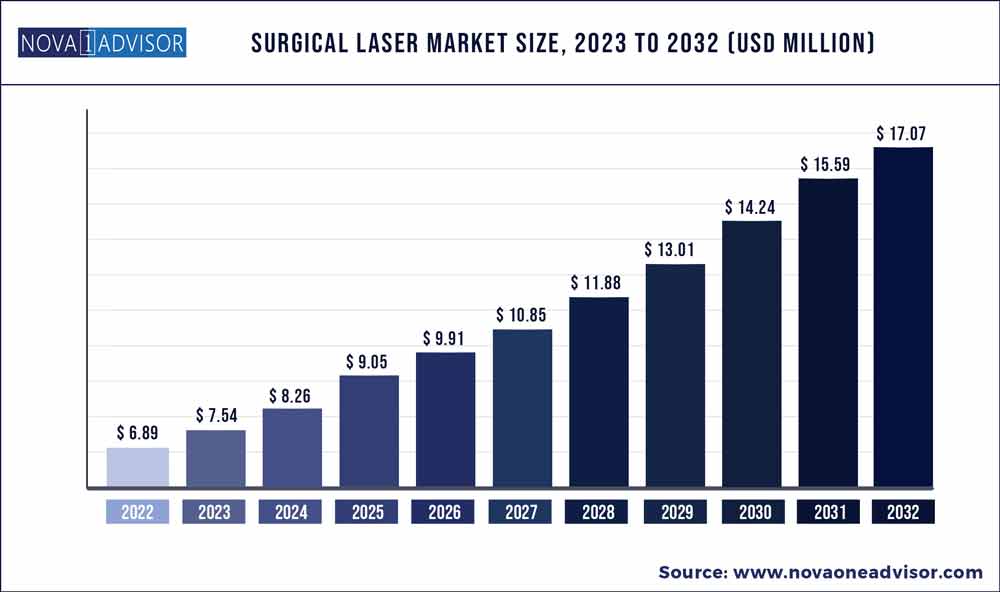The global surgical laser market size was exhibited at USD 6.89 billion in 2022 and is projected to hit around USD 17.07 billion by 2032, growing at a CAGR of 9.5% during the forecast period 2023 to 2032.

Key Pointers:
- North America accounted for the largest revenue share of around 49.2% in 2022
- In Asia Pacific, the market for surgical lasers is expected to grow at a lucrative rate over the forecast period.
- The solid-state laser systems segment is expected to account for the largest revenue share of 42.7% in 2022
- The hospital segment dominated the market for surgical lasers and accounted for a revenue share of 48.4% in 2022.
- The aesthetic segment captured 37.3% of the revenue share in 2022
Surgical Laser Market Report Scope
| Report Coverage |
Details |
| Market Size in 2023 |
USD 7.54 Billion |
| Market Size by 2032 |
USD 17.07Billion |
| Growth Rate From 2023 to 2032 |
CAGR of 9.5% |
| Base Year |
2022 |
| Forecast Period |
2023 to 2032 |
| Segments Covered |
Product, Application, End-use |
| Market Analysis (Terms Used) |
Value (US$ Million/Billion) or (Volume/Units) |
| Regional Scope |
North America; Europe; Asia Pacific; Central and South America; the Middle East and Africa |
| Key Companies Profiled |
Cynosure, Inc.; Lumenis Ltd.; Candela Corporation; Cutera, Inc.; Lutronic Corporation; El.En Group; Fotonad.o.o; Alcon; Biolase; Asclepion Laser Technologies GmbH
|
Surgical lasers refer to the usage of lasers for the undertaking of a surgical procedure. Lasers are defined as devices which emit light with the help of the optical amplification procedure based on the stimulated emission of electromagnetic radiation. In contrast to the usage of a scalpel to conduct conventional surgeries, surgical lasers involve the use of a laser to cut tissues amongst the other surgical tasks. Surgical lasers have a number of effects such as photochemical effects, photomechanical effects, photoablative effects, and photothermal effects.
Some of the application of surgical lasers include oncological surgeries such as esophageal and bronchial carcinoma, eye surgeries such as band keratoplasty, endoscopic control of bleeding and intraluminal lithotripsy. The benefits of surgical lasers include bloodless field, better healing, precise microsurgeries, lessen postoperative pain, and lower infection rate but precautions must be undertaken for complications such as atmospheric contamination, interstitial pneumonia, inflammation, and bronchiolitis. These trends have contributed to the positive growth of the global surgical lasers market.
The global surgical lasers market is anticipated to grow, owing to a number of factors such as increased prevalence of acute and chronic diseases such as cancer and eye disorders, innovations in technology, increasing demand for minimally invasive surgeries. Moreover, greater demand for medical procedures with greater patient comfort, increasing awareness regarding surgical procedures, and increasing geriatric populations are also anticipated to drive the market growth. According to the American Cancer Society (ACS), it is estimated that there would be 1,735,350 new cancer cases diagnosed in 2018.
In estimates released by the Centers for Disease Control and Prevention (CDC), it was stated that coronary artery disease (CAD) was the leading cause of heart disease in the U.S., which can be treated using the surgical lasers such as trans-myocardial laser revascularization successfully for those individuals who cannot undertake a bypass surgery. These trends combined with the other factors are expected to positively drive the market growth.
The factors limiting the growth of the global surgical lasers markets include the high costs of the procedures, lack of medical reimbursements and the safety concerns associated with surgical lasers.
Some of the prominent players in the Surgical Laser Market include:
- Cynosure, Inc.
- Lumenis Ltd.
- Candela Corporation
- Cutera, Inc.
- Lutronic Corporation
- El.En Group
- Fotonad.o.o
- Alcon
- Biolase
- Asclepion Laser Technologies GmbH
Segments Covered in the Report
This report forecasts revenue growth at global, regional, and country levels and provides an analysis of the latest industry trends in each of the sub-segments from 2018 to 2032. For this study, Nova one advisor, Inc. has segmented the global Surgical Laser market.
By Product
- Solid-state Laser Systems
- Erbium Yttrium Aluminum Garnet (Er: YAG)
- Neodymium Yttrium Aluminum Garnet (Nd: YAG)
- Holmium Yttrium Aluminum Garnet (Ho: YAG)
- Ruby Laser Systems
- Others
- Gas Laser Systems
- Diode Laser Systems
- Others
By Application
- Surgical
- Aesthetic
- Dentistry
- Ophthalmic
By End-use
- Hospitals
- Specialty Clinics
- Ambulatory Surgical Centers
By Region
- North America
- Europe
- Asia-Pacific
- Latin America
- Middle East & Africa (MEA)

